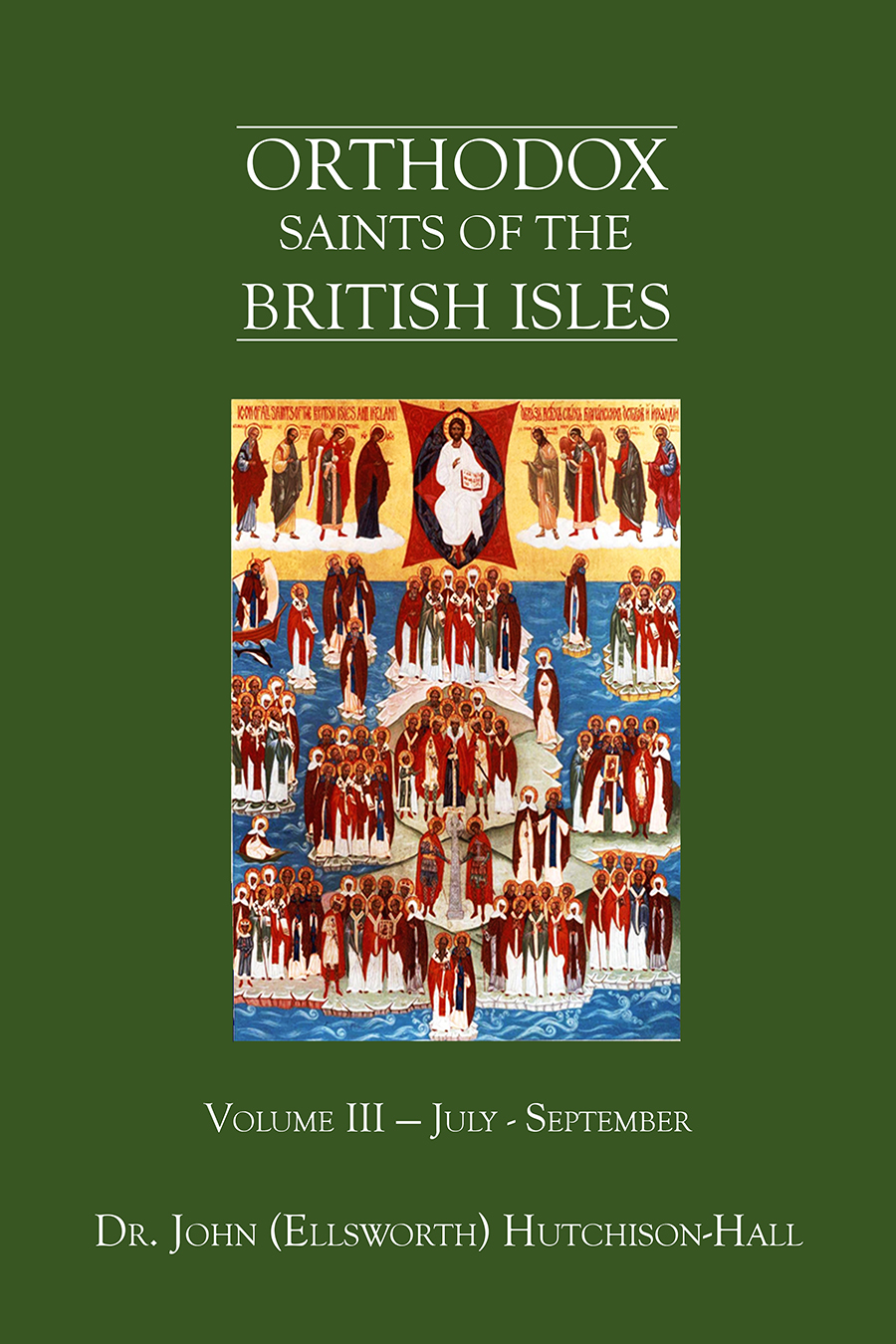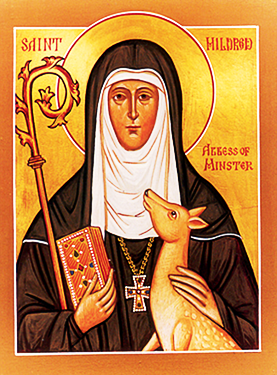
Orthodox Saints of the Pre-Schism
See of Rome
13th July (NS) — 30th June (OS) 2023
BERTRAND of LE MANS, born in Autun, Burgundy (France), he studied under St. Germanus of Paris (28th May) who priested him upon completion of his studies. St. Bertrand served as Archdeacon of Paris, and was consecrated Bishop of Le Mans (north-western France) in 587. While Bishop, St. Bertrand founded a monastery and hospice in his See. He was also known for his keen interest in agriculture and viniculture, and produced a well-respected wine. St. Bertrand reposed in 623.
CLOTSINDIS (CLOTSEND) of MARCHIENNES, a daughter of SS. Adalbald of Ostrevant (2nd February) and Richrudis of Marchiennes (12th May), St. Clotsindis received monastic tonsure at the abbey founded by her mother and later known as the Abbey of St. Rictrude and St. Peter of Marchiennes (abbaye Sainte-Rictrude et Saint-Pierre de Marchiennes) on the Scarpe River in present-day Hauts-de-France. Following the repose of St. Rictrudis in 688, St. Clotsindis became Abbess. St. Clotsindis reposed in 714.
EMILIANA of ROME, (Date Unknown), a virgin-martyr in Rome of whom nothing further is known.
ERENTRUDE (ERENTRUDIS), a sister, or possibly niece, of St. Rupert of Salzburg (27th March), Apostle of Austria. St. Erentrude was the first Abbess of Nonnberg in Salzburg (Austria), which was founded for her by St. Rupert. St. Ermentrude reposed circa 718.
EURGAIN, (Sixth Century), St. Eurgain was the daughter of a Welsh chieftain and foundress of Cor-Eurgain, later known as Llantwit, in the Vale of Glamorgan, Wales.
GAIUS and LEO, (Date Unknown), SS. Gaius, a priest, and Leo a subdeacon, martyrs whose names have appeared in martyrologies since time immemorial. Unfortunately no further information of their lives, including date and place of their martyrdom is extant.
LUCINA of ROME, (Date Unknown), a Roman matron who was inspirited to convert by the example the Apostles. Following her baptism, St. Lucina devoted her time and wealth to the work of the Church, visiting imprisoned Christians, and providing burials for martyrs, including, it is said, SS. Processus and Martinian of Rome (2nd July). St. Lucina flourished during the reign of Emperor Nero (r. 54–68), more exact dates are unknown.
MARCIAN of PAMPELUNA, a Bishop of Pampeluna (present-day Archdiocese of Pamplona y Tudela, Spain). Sources place the date of St. Marcian’s repose as circa 757, and then state he was in attendance at the sixth Council of Toledo which was held in 638. At this point I have not been able to locate information that reconciles this obvious discrepancy.
MARTIAL, ALPINIAN, and AUSTRICLINIAN of LIMOGES, Martial, the first Bishop of Limoges (southwest-central France), and Apostle of the Limousin (region of south-central France), together with two of his priests. There is practically nothing in the way of reliable information extant about these Saints. The year of their repose is generally believed to be circa 250.
OSTIANUS, (Date Unknown), a saint, generally said to have been a missionary priest in the area of Viviers in France. No authoritative information on his life is extant.
PROTOMARTYRS of ROME, an unknown number of Apostolic Era Christians, who, having been charged by Emperor Nero (r. 54–68) with burning down Rome in 64, were martyred in a variety of horrifically barbaric ways.
Get your copy of Orthodox Saints of the British Isles today.
Available at Amazon or your favourite e-bookstore.
DOGFAN (DOEWAN), (Fifth Century), one of the sons of the great King St. Brychan of Brycheiniog (6th April), St. Dogfan is believed to have been martyred by pagan invaders in Dyfed (Pembrokeshire), Wales. A church was built there in his honour.
EUGENE, SALUTARIS, MURITTA, and COMPANIONS of CARTHAGE, Eugene was consecrated Bishop of Carthage (a present-day suburb of Tunis, Tunisia) in 481, and soon afterwards was exiled to the surrounding desert by the Arian Vandals along with either, the entirety of the clergy of all ranks of his diocese numbering in excess of 500, or, as other sources state, an unknown number of his flock, including children. Regardless of the make-up of his fellow exiles, all suffered greatly for the true faith. Permitted to return to Carthage in 488, St. Eugene was exiled again in 496, this time he managed to settle in Albi in south-eastern Italy. There St. Eugene reposed in 505 from the toll his mistreatments had taken upon him. St. Eugene and his flock are counted amongst the Martyrs of the Church due to their suffering.
MILDRITH (MILDRED) of THANET, The daughter of St. Ermenburgh (19th November) and sister of SS. Mildburg of Much Wenlock (23rd February) and Mildgyth (17th January), St. Mildrith was sent at an early age to be educated at Chelles Abbey near Paris in France. Returning to England, she received monastic tonsure from St. Theodore of Canterbury (19th September) at her mother’s monastery of Minster-in-Thanet, in Kent. St. Mildrith succeeded her mother as Abbess upon St. Ermenburg’s repose. As Abbess, St. Mildrith earned a reputation for patience, love, and kindness. Following a long illness, St. Mildrith reposed circa 700, and was succeeded by St. Eadburh of Minster (13th December). St. Mildrith was a popular saint in the years following her repose, and her local cultus eclipsed even St. Augustine of Canterbury (27th May). The bulk of St. Mildrith’s relics were translated to Canterbury in 1033, with some minor relics translated to Deventer in Holland where she was also venerated.
Troparion of St. Mildrith of Thanet — Tone IV
Through constant prayer and frequent fasting, by ceaseless hymnody
and great humility, the glorious Mildrith forsook the allurements of
her royal rank, trampling underfoot all worldly pride and
presumption. Wherefore, let us imitate her virtues, that, free from
all earthly attachments, we may join her at the wedding feast of
Christ our Saviour.
TURIAF (TURIAV, TURIAVUS) of DOL, a French nobleman who became a monk, priest and later Bishop of Dol in Brittany (north-western France). St. Turiaf reposed circa 750.
Prior to the Schism the Patriarchate of Rome was Orthodox, and fully in communion with the Orthodox Church. As Saint John of Shanghai and San Francisco +1966 said “The West was Orthodox for a thousand years, and her venerable Liturgy is far older than any of her heresies”.
Details of British Saints excerpted from Orthodox Saints of the British Isles.
Details of continental saints from these sources.
In many cases there are several spelling versions of the names of saints from the British Isles. I use the Oxford Dictionary of National Biography version as the primary version with the more prevalent version in parenthesis e.g. Ceadda (Chad) of Lichfield.


